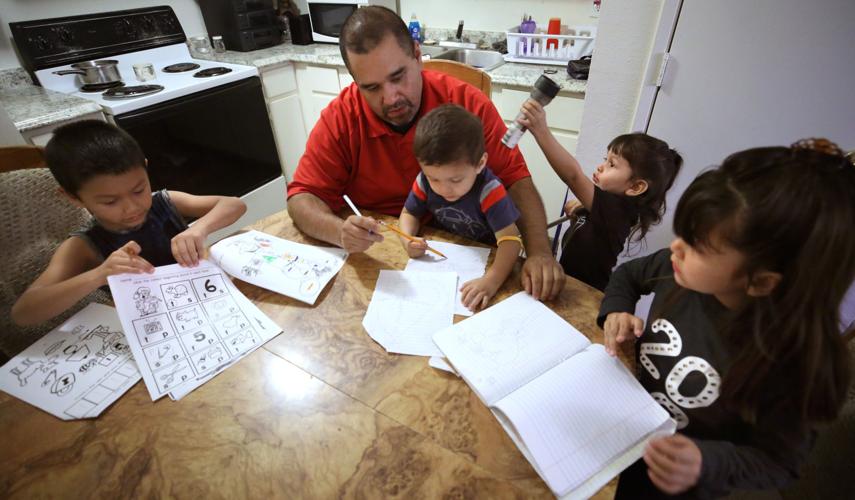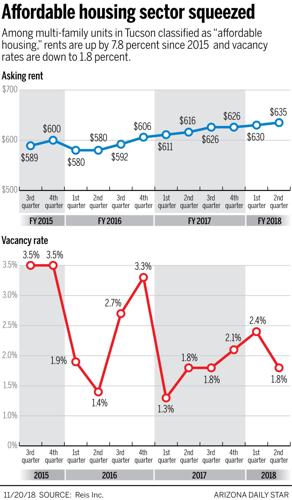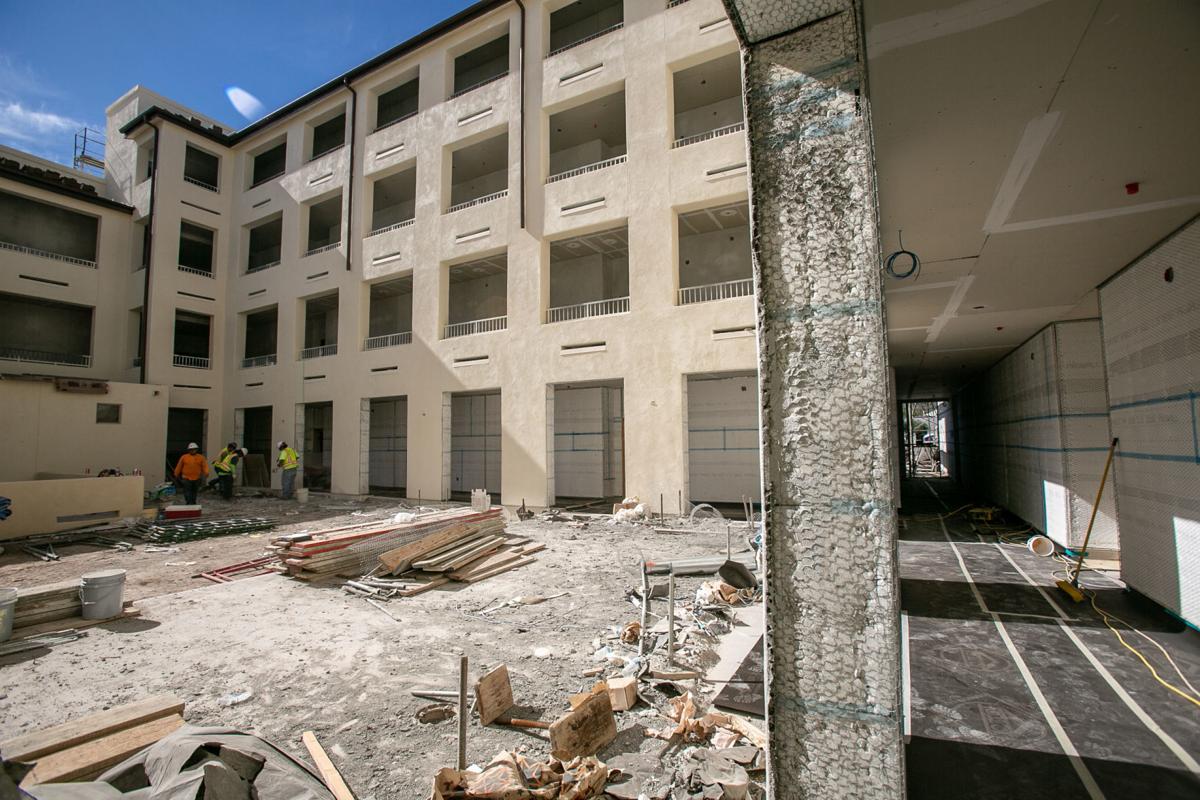This is part 3 in a three-part series. Click the below links to read parts 1 and 2.
Some state-level reforms could help alleviate the fallout from housing instability and eviction actions in Tucson — and one of the most fundamental would be to boost the supply of affordable housing, advocates say.
The Arizona Housing Coalition is advocating for a state-level tax credit to support low-income housing development, as a complement to the federal Low-Income Housing Tax Credit program.
“There’s a lot of market-rate apartments going up, but that doesn’t necessarily mean that older properties are all the sudden going to become affordable,” said Joan Serviss, director of the Arizona Housing Coalition, created through last year’s merger of the Arizona Housing Alliance and the Arizona Coalition to End Homelessness. “There’s not a trickle-down concept.”
Some legislators object to the idea because it would involve a hit to the state’s general fund. Supporters counter that investing in affordable housing will ultimately pay off in reduced homeless services expenditures and improved economic stability for low-income renters.
“Stable housing is a foundational need,” said Andrew Aurand, vice president for research at the National Low-Income Housing Coalition.
Housing is crucial to maintaining a job and economic mobility, and for students to reach higher educational achievement, he said. It’s also central to a person’s well-being, he said. Unstable or inadequate housing, and related stress, negatively impact physical and mental health, according to research highlighted in a June article in the journal Health Affairs.
The federal tax-credit program is responsible for about 90 percent of the affordable rental units built in the U.S.
“It has been one of the most successful federally run and state-administered programs that has ever rolled out from the federal government,” said Adam Weinstein, president and CEO of Tucson developer Gadsden Co.
Rising construction costs and the specter of international tariffs are making it more difficult to finance housing projects, Weinstein said. Those tax credits and other public support make those projects feasible, he said.
“They’re absolutely mission critical,” he said.
Gadsden’s affordable housing project West End Station, west of Interstate 10 on West Congress Street in the Mercado District, is one of the first Tucson projects that used the federal tax-credit program for workforce housing, Weinstein said. Gadsden is co-developing the project with Gorman & Co.

Kitchen cabinets are installed at West End Station. The 70-unit complex was one of the first in Tucson to use a federal tax credit to create workforce housing.
“This is really bringing in a much higher level quality of garden-style, urban infill apartment living that is not a stigma to the local area where it’s being developed,” he said. “They’re built to design standards that are complementary to adjacent market-rate properties.”

The Arizona Housing Coalition has also been pushing for the state to expand funding for the State Housing Trust Fund, which until the recession was funded by 55 percent of revenues from the sale of unclaimed property. At its peak, the fund reached about $30 million, Serviss said.
But in the wake of the housing market crash, as policymakers looked to cut spending wherever possible, they redirected unclaimed-property sales revenue to the general fund and capped the amount appropriated to the housing trust fund at $2.5 million, she said.
Lifting the cap would expand access to a flexible funding source that can fund programs ranging from homelessness and eviction prevention, to gap financing to support low-income housing development, Serviss said.
Rep. Lela Alston, D-Phoenix, has repeatedly introduced legislation to lift the cap, but the bills have never made it to the floor, she said. That may change this upcoming session, as a group of legislators has recently come together to focus on homelessness, eviction prevention and housing instability, spurred in part by media attention to the issues, she said.
“So many people are a paycheck away from being homeless,” Alston said. “It’s so much cheaper, and better for the families, to keep people in their homes rather than to have them evicted and then be on the streets and try to start from ground zero, rebuilding what we can.”
RIGHT TO COUNSEL
Ensuring due process for tenants in eviction court is also critical, legal advocates say.
A tenant with an attorney is far more likely to prevail in eviction court, said Sabrina Fladness, housing attorney for Southern Arizona Legal Aid.
“If you’re in danger of going to jail, you get a (court-appointed) lawyer,” Fladness said. “But if you’re going to lose your house, you don’t get a lawyer. I don’t think it makes sense.”
Right-to-counsel laws are gaining traction nationwide. Last year, New York Mayor Bill de Blasio signed legislation guaranteeing free legal representation to income-eligible tenants facing eviction. The program covers tenants earning up to 200 percent of the poverty level and will be phased in over five years.
The basic argument for guaranteed representation is rooted in the right to due process, said Susanna Blankley, coalition coordinator for Right To Counsel NYC, which advocated for the law.
“It’s hard to a wage a campaign against it,” she said. “It doesn’t mean you can’t still evict people. It just means that when you walk into court, and you have something at stake as central to your life as your house, then you should have full access to the laws that protect your right to be a tenant.”
Providing representation in housing court can cost up to $3,200 per case, but each bed in a New York City homeless shelter costs $34,000 per year, the coalition said.
By 2022, New York will spend $155 million annually on the program. An analysis by a neutral financial firm found the right-to-counsel law would not only pay for itself, but would save the city $320 million annually in costs like spending on homeless services and emergency room visits, Blankley said.
“We blame people being evicted for being evicted,” Blankley said. “And yet, there are people evicting them who make a lot of money from their investments in housing. Who are they? Why do they have such control in the court system? Those are important questions to be asking in Arizona and everywhere.”
New York’s anti-eviction reforms, including the right-to-counsel law, contributed to a 27 percent decline in evictions between 2013 and 2017, a report from the city’s Office of Civil Justice said.
Pima County Judge Pro Tem Ronald Newman said right-to-counsel sounds like a good idea. Sometimes he sees tenants missing out on opportunities to argue a legal point, but as an impartial judge, he can’t weigh in.
But for the large number of eviction cases in which a tenant has already made a mistake, such as by withholding rent to try to pressure their landlord to make repairs, without first giving written notice — those situations can’t be fixed by getting legal representation on the back end, said Judge Vince Roberts, justice of the peace in Pima County Consolidated Justice Court and a former constable.
“Most people didn’t know the law up front,” he said. “Your lack of knowledge in the first place isn’t a justifiable reason why you shouldn’t be evicted.”
Some advocates are pushing to slow down the eviction court proceedings to give tenants more time to find legal help or to mount their own defense.
More time won’t help in most nonpayment of rent cases, and property owners argue that adding more time to the process will contribute to damages for landlords who find it’s already a struggle to get rid of bad tenants.
“It’s a tightrope sometimes to figure out what the timeframe is that’s fair and equitable for both parties,” Roberts said.
But there are plenty of cases in which that extra time could save homes, housing attorneys say.
Sometimes, a simple nonpayment of rent case is not so simple, said Stan Silas, senior staff attorney with Community Legal Services, which provides legal counsel to low-income tenants in central and western Arizona.
“What we as legal aid attorneys see every day is evictions that are based on improper motivations, improper imposition of facts and the wrong analysis of the law,” he said. “We never go to court on nonpayment cases unless there’s valid defense.
“Without representation, the tenant’s not going to be able to successfully assert those defenses to an unlawful eviction,” Silas said. “We can only represent a small percentage of those individuals. Don’t get caught up in the hype that it’s just about nonpayment of rent. That’s the tip of the iceberg.”

Guillermo Hernandez, who got rent assistance from the Primavera Foundation, juggles helping his older kids with their homework while keeping the two younger ones occupied. Hernandez received custody of his children, from left, Alejandro, Dominic, Angelica and Lylianna, in December. Local agencies providing rent assistance say they can’t keep up with demand.
EVICTION PREVENTION FUNDS
For single dad Guillermo Hernandez, 42, getting a couple months rent covered by the Primavera Foundation was enough to help him through a rough patch. Last year, Hernandez was working to get custody of his four children. He’d been separated from the mother of his children when the kids were taken into state custody two years ago, after their youngest baby was born with opioids in his system.
“I fought hard” to get custody, he said. “I wouldn’t trade it for the world, just being able to see my kids every day and them always telling me, ‘We love you, Dad.’ “
Hernandez said he was eager to fulfill all the requirements from the Arizona Department of Child Safety, such as attending parenting classes. But the time-consuming obligations meant he could only work part-time.
In the weeks leading up to his kids moving in with him, Hernandez asked the DCS agency overseeing his kids’ case if he could get a break from the classes to secure full-time work. Through a temp agency, he got a job at a Lexus dealership in December, the same month he got custody of his children. After three months, he was hired on a permanent basis and is now a service representative.
But the transition was tight financially. DCS told Hernandez he had to get a two-bedroom place to have enough room for the kids. Without help from Primavera, he said he wouldn’t have been able to afford it.
Primavera fully covered those two months, as well as paid for a new transmission in his broken-down truck. Now, with his full-time job well underway, Hernandez says his finances are under control and his housing situation is stable. He’s already on the lookout for another place with more responsive management, but he’s struggled to find higher-quality housing within his budget, he said.
“If you do find housing that’s affordable, it’s usually pretty rundown and the landlords don’t take care of you at all,” he said.
The Arizona Department of Housing has proposed using $2 million from the State Housing Trust Fund for an eviction-prevention pilot program that would bolster resources for agencies like Primavera who are helping tenants avoid evictions. Starting in early 2019, an allocation of $575,000 will be dedicated to zip codes in Pima County where the most eviction orders are enforced, said Janelle Johnsen of the housing department.
The funds would be targeted toward tenants who have a one-time need due to an emergency situation, but will be able to afford their rent the following month, Karia Basta of the Arizona Department of Housing said during a Tucson public forum on the pilot program. That’s to avoid sinking funds into unsustainable housing situations.
“We don’t want to be postponing the inevitable,” she said.
The pilot program will also streamline referrals to legal aid attorneys, but won’t provide any additional funding for them at this time. More funding would be a far greater help, said Matthew R.K. Waterman, managing attorney for Southern Arizona Legal Aid.
“I have a line of people out my door that stretches back to infinity,” he said. “We don’t need another referral source. Either you can provide funding for us to expand our program or there’s nothing we can do to assist you, because we’re fully booked up as it is.”
LOCAL ATTENTION
Tucson attorney Stacy Butler created the Innovation for Justice program at the University of Arizona’s James E. Rogers College of Law. Students in the program are researching and developing solutions to help tenants facing eviction. Butler is also founder of Step Up to Justice, a pro-bono civil legal service that connects low-income defendants with volunteer attorneys.
One of the focuses of the Innovation for Justice evictions course will look at ways to encourage tenants to show up to court. Butler’s students observed 223 eviction cases in Pima County Consolidated Justice Court in August and found that less than 20 percent of tenants showed up for their hearing, Butler said.
And the city’s Ending Poverty Now initiative recently added a committee focused on evictions, at the suggestion of Bennett Bernal, one of Pima County’s 10 constables who enforce eviction orders if tenants haven’t left their homes voluntarily.
Precinct 6 Constable Bernal said he’s been on the job for seven years. Carrying out eviction orders weighs on him, particularly when it involves children or older adults, he said. He hopes to find ways to prevent unnecessary evictions, and better prepare tenants for the consequences of an eviction.
“We have a terrible job,” he said. “No constable thinks, ‘Oh great, we’re gonna evict today.’ “
The Ending Poverty Now’s eviction committee will initially focus on mitigating the fallout from evictions, and then will turn to eviction prevention, said Bonnie Bazata, program manager. Current efforts include creating a resource guide for evicted tenants and a pamphlet with post-eviction advice, such as how to keep one’s child in the same school and to disconnect utilities before vacating the property to protect your account from fraudulent use, Bazata said.
FEDERAL HOUSING ASSISTANCE
Housing advocates say ultimately, it’ll take a nationwide commitment to make a dent in a housing crisis that’s been decades in the making. That would mean a significant increase in federal funding for rent- and utility-assistance, like the Housing Choice Voucher program, also known as Section 8.
Too many Americans simply can’t afford housing in today’s economy, in which increasing housing costs have outpaced wage growth.
“When there’s a disconnect between what people can pay and what landlords are charging, I don’t think our societal solution should be to forcibly put people on the street,” said Blankley of the Right to Counsel NYC coalition.
In Pima County, renters would have to earn $16.42 per hour to be able to afford a two-bedroom apartment at the fair market rent of $854, while the average renter wage here is $13.54, according to analysis by the National Low-Income Housing Coalition. Across Arizona, a renter would have to work 56 hours per week at minimum wage to afford a one-bedroom.
Federal housing assistance funding hasn’t kept pace with the growing need: Only one in four eligible renters who qualify for rent assistance actually gets it, due to those funding limitations.
In Arizona, the disparity is even greater, with just one in six, or 17 percent, of qualified renters actually receiving the rent assistance for which they’re eligible, according to progressive think-tank Center on Budget and Policy Priorities, or CBPP.
Most of the country’s 2.2 million housing vouchers were distributed by 1995, with the allocation based on HUD’s assessment of housing needs at the time, said Barbara Sard, CBPP vice president for housing policy. Arizona has such a large unmet need for vouchers because its population has grown more dramatically, compared with much of the country, since those allocations were done, she said.
Congress boosted HUD’s budget by 10 percent in fiscal year 2018, but the department’s funding for most programs is still well below fiscal year 2010 levels, the National Low-Income Housing Coalition reports. Federal rental assistance program funding is down by $266 million, or 28 percent, compared to 2010.
The Trump administration’s proposed cuts to next year’s housing budget would have worsened the housing crisis, but both chambers of Congress have restored the cuts, said Serviss, of the Arizona Housing Coalition. The final budget will likely be enacted in December.
“I guess we should be pleased there’s not cuts” in this year’s federal budget, she said. “But as we see increasing numbers of individuals and families experiencing homelessness, and that’s all correlated to the lack of affordable housing, we need to not see stagnant funding — we need to see increases.”








